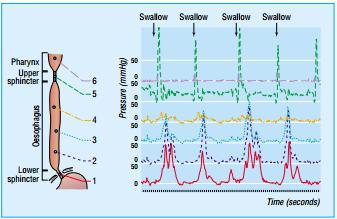When tests are being done to diagnose whether or not you have achalasia, a manometry test is often carried out. This consists of a thin pressure-sensitive tube that is passed through your oesophagus to measure the pressure at various points along the length of the oesophagus.
The results indicate how well the muscles are working for 'peristalsis' (the process of muscles that normally synchronise in a succession of contractions that propels the bolus, or swallowed portion of food, towards the stomach). There are nerve cells called ganglia that control these muscles, and it is often these nerve endings that stop the muscles working properly rather than a problem with the muscles themselves. The muscles often naturally work, if left to themselves, by clamping shut with relatively high pressure, and it is the job of inhibitory nerve cells to allow those muscles to relax and let food pass through.
With achalasia, it is frequently the muscles at the lower oesophageal sphincter (LOS - located at the diaphragm at the junction between your stomach and the oesophagus) that are most affected. The sphincter valve then clamps tight shut, and food backs up in the oesophagus.
The value of manometry is that it can indicate the pressure that the muscles are exerting along the whole length of the oesophagus. If a myotomy procedure is then carried out, the surgeon will have the best information about the precise length and location of muscles to cut in order to achieve enough relaxation of the LOS.
Manometry can last for an hour or so, but sometimes for longer. High resolution manometry is increasingly being used by treatment centres as this more modern equipment is better for patient comfort and also gives much more detailed results.
